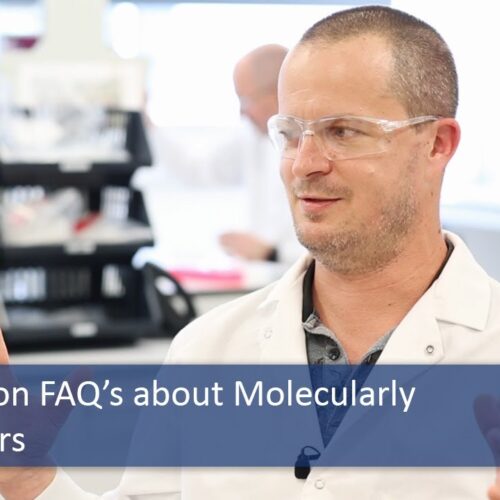Answering FAQ’s about Molecularly Imprinted Polymers
The MIP Discovery Video Series gives an introduction to Molecularly Imprinted Polymers, explaining what they are, how they are made and their applications in medical diagnostics and healthcare. In the final instalment of this video series, the MIP Diagnostics team answer some of the most frequently asked questions we get about molecularly imprinted polymers.

Video Transcript
Keli:
Welcome to the MIP Discovery Series. In this video I’m going to be joined by various members of the MIP Diagnostics team to answer some of the most frequently asked questions about molecularly imprinted polymers. First up I am joined my Dr Antonio Guerreiro, who is director of technology at MIP Diagnostics. So Antonio, we often get asked, what type of targets can MIPs be generated to?
Antonio:
So MIPs can be generated against a very wide range of target sizes, so they can target for instance very small molecules such as ions. For example MIPs are very good binders for phosphate ions. They can also be generated against small target molecules such as drugs, explosives and toxins, which is a very good target size for a MIP. Next size up we have peptides, so we can generate MIPs against a variety of peptides, and if we use a specific peptide that’s on the surface of a protein, an epitope, we can generate MIPs against full proteins. Now if those proteins are at the surface of a cell or the surface of a viral particle then we can generate a MIP that recognizes a full, or a whole cell, or a full virus, or a fraction or segment of that virus. So in summary we can generate MIPs for very small molecules such as ions, right through to very large, such as a full cell.
Keli:
Excellent, thanks that’s a great answer, thanks Antonio. Next I am joined by Alice Mazzer, who is one of our senior scientists at MIP Diagnostics. So Alice, one of the questions we get asked quite a lot is how long does it take to develop a brand new MIP?
Alice:
Right, a new MIP. I say it depends on the complexity of the target, but typically the process is about 8 – 12 weeks. We start with molecular modelling to identify the best monomers to get a nice, high affinity MIP, we then take the process into the lab where we produce and characterize the MIPs, and finally we carry out any refinements before getting the product to the customer.
Keli:
Excellent, that’s a lot quicker than traditional reagents such as antibodies.
Alice:
Yes, 8 to 12 weeks, it can be done!
Keli:
Great, thanks Alice. So I am now joined by Shelly Bennet who is a senior scientist at MIP Diagnostics. Hi Shelly, so a question we often get asked is how do you actually choose the monomers that you use when you produce a new MIP?
Shelly:
So we have a specialist modelling software and this allows us to screen the targets against lots of different monomers. The binding of the monomers to the target is then assessed in terms of hydrophobic interactions, hydrogen bonding, and hydrophilic interactions. The best binders are then chosen and formulated into different compositions, and we then test these in the lab.
Keli:
Excellent, and are there any limitations? Can you analyze a full protein, or a certain portion of the protein?
Shelly:
Yes, so we analyze the protein, and also sections of the protein, and we can then compare which section of the protein is best to target.
Keli:
Excellent, thank you very much. So next up I am joined by the Head of Chemistry at MIP Diagnostics, Dr Francesco Canfarotta. Hi Francesco. So with any new technology, we are bound to be asked how it compares with existing products on the market. So how do MIPs compare with antibodies?
Francesco:
Well as demonstrated by one of our collaborators at Newcastle University, Dr Marloes Peeters, our COVID NanoMIPs have demonstrated to outperform monoclonal antibodies. In particular the sensor platform showed a greater sensitivity when the nanoMIPs were used as the binding agent by achieving a lower limit of detection of about 20 fold.
Keli:
That’s excellent. And how about integrating them into a sensor device, is that a simple process?
Francesco:
It is, it is very rapid because we have got complete control over the surface chemistry, we can easily integrate these particles into any sensor platform, depending on the chemistry that is needed for the coupling process.
Keli:
Excellent, thanks very much Francesco.Finally I am joined by our Chief Scientific Office at MIP Diagnostics, Alan Thomson. Hi Alan, so I have saved the most difficult question for last for you, and that is, what does the future hold for molecularly imprinted polymers?
Alan:
I think the future for molecularly imprinted polymers, and for us as a company, is to get acceptance in the marketplace. We have come a long way in doing that, we have taken the technology a long way from what people might remember of imprinted polymers in the past, and we are generating data regularly that exceeds anything achieved with molecularly imprinted polymers previously. So our job now really is to gain that market acceptance and see MIPs in final products.
Keli:
And do you envisage any particular platform that we will see steam ahead?
Alan:
So far the adoption has been best with the next generation of sensors, and if we take that to its logical conclusion its likely that we’ll see MIPs enabling wearable sensors in particular over the next three to five years.
Keli:
Excellent, great it looks very promising, thank you very much Alan. Well that’s the end of our video series, I hope you found these videos informative and if you have any questions please get in touch with us at MIP Diagnostics. Thanks for watching.

